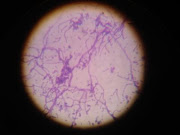Abstract
(Poster Presentation on Virtual
12th ECTMIH; Sept 28 - Oct 1, 2021)
Tropical Medicine & International
Health volume 26 suppl 1 pp 41 September
2021
324
Emergence of multi-drug resistant bacterial
infection of lower respiratory tract among people living with HIV
R. Maharjan1, A. Bastola2,
N. Adhikari1, K. R. Rijal1, P. Ghimire1 and U.
T. Shrestha1
1Central Department of Microbiology, Tribhuvan University, Kathmandu, Nepal;
2Sukraraj Tropical and Infectious Disease Hospital, Teku, Kathmandu, Nepal
BIOGRAPHY: Upendra Thapa Shrestha, Lecturer, Central Department
of Microbiology, Tribhuvan University, Kathmandu Nepal (Institutional Email:
upendra.thapashrestha@ cdmi.tu.edu.np). Currently; PhD Scholar; Faculty of
Tropical Medicine, Mahidol University, Bangkok, Thailand (Email: upendrathapa.shr@student.mahidol.edu).
Goal: Applied Molecular Microbiology research and its application
in human beings
Publications: More than 24 articles in national and international
journals
Current status: working on diagnosis of acute
undifferentiated febrile illness with focus on arboviral infections using
multiplex real-time RT-PCR based on three tertiary care hospitals in Nepal Research
Grants Awarded from: University Grants Commission, Nepal, Ministry of Science
and Technology, Nepal, USAID, USA
Other interested research area: Malaria, antimicrobial resistance
OBJECTIVES This study aimed to determine the
prevalence of lower respiratory tract infection among HIV due to
multidrug-resistant pathogens and to detect plasmid-mediated blaTEM and bla
CTX-M genes among Extended-Spectrum Beta-Lactamase (ESBL) producing isolates
from sputum samples in Sukraraj Tropical and Infectious Disease Hospital,
Kathmandu, Nepal.
METHODS A total of 263 sputum samples from confirmed HIV-positive cases were processed with standard microbiological methods to isolate and identify the possible pathogens. The identified bacterial isolates were subjected to antibiotic susceptibility testing using modified Kirby Bauer disk diffusion following Clinical Laboratory Standard Institute (CLSI) guidelines. Multidrug-resistant and ESBL producers were screened and confirmed. Plasmids from those ESBL producers and Mstrains were extracted and screened for ESBL genes; blaCTX and blaTEM by conventional PCR method using specific primers.
RESULTS of 263 sputum samples, 67 (25.5%) were culture positive showing Klebsiella pneumoniae (17, 25.4%) as the most predominant one. A higher rate of infection (4/8, 50%) was seen among older people of 61–70 years, whereas no infection was seen below age 20. About 30.0% (n = 15) of smokers, 32.9% (n = 23) cases with previous pulmonary tuberculosis and 39.8% (n = 7) of people with CD4 counts <200 cells/μl were found to be more susceptible towards LRTIs. Among 53 bacterial isolates in Enterobacteriaceae family, 52.8% (n = 28) were multidrug-resistant and 43.3% (n = 23) were ESBL producers. All ESBL producers were sensitive to Colistin and Polymyxin B. of 23 ESBL producers, 95.6% (n = 22) and 52.1% (n = 12) possessed blaCTX-M and blaTEM genes respectively in their plasmid, which may transfer both vertically and horizontally resulting in higher rate of ESBL producers.
CONCLUSION The increasing rate of bacterial infections
mainly ESBL producers of LRTIs among people with HIV causes difficulty in the
management of diseases leading to high morbidity and mortality among HIV patients.
KEYWORDS: HIV, Lower respiratory tract infection, ELBL, blaCTX,
blaTEM























